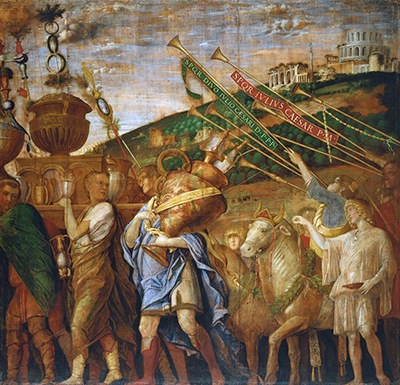This is one of the best masterpieces in Italian Renaissance art. The painting was done most probably for Francesco II Gonzaga who was the 4th Marquis of Mantua in 1484.
In 1692, Triumphs of Caesar which is one of nine canvases was acquired by Charles I in 1629. Since 1630, the paintings have been hung at Hampton Court close to London. They are placed in a special gallery in a new continuous frame so that it can capture their original look and setting. The painting was done using the technique referred to as tempera, on canvas that measured 267x278 cm. Mantegna was an important humanist painter during his time, and his interest in literature and archaeology gave him the foundation of art that was directed towards the upper class. This led him to create the Triumph of Ceasar, which he painted for a decade since 1485-1495.
Over the years, there have been numerous repaintings that have been done on them for restoration purposes. If you combine each canvas, it spans 70 meters. The painting illustrates Ceasar who is returning from successful campaigns, in a procession of standard-bearers, Roman soldiers, musicians, exotic animals, captives, and other assortments like arms, gold vases, and intricate sculpture. Mantegna was inspired by the written accounts of the celebratory processions and the antiquities that were in the possession of the Duke. After their sale in 1629, the collection did not retain its original style, and a disastrous restoration happened, that caused a rash decision to be made where the collection was dipped in paraffin wax.
This made the paintings temporarily lose certain parts of their respective compositions. But in 1962, a new restoration was completed by John Braeley, who was supervised by Anthony Blunt to produce an improved finish that did indeed return many of the lost details of each work. Sadly there have been many other tales of failed restorations over the years, meaning some items have been damaged, even with the best of intentions. Thankfully the most recent work completed in the 1960s were more professionally done and has at the very least ensured that these paintings will not deteriorate any further than they already have. They are also now housed in a carefully planned setting which is intended to protect them from future damage.




